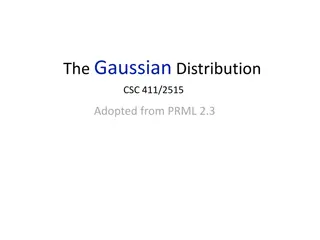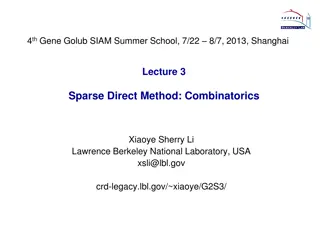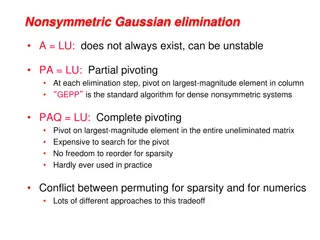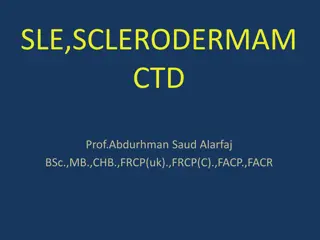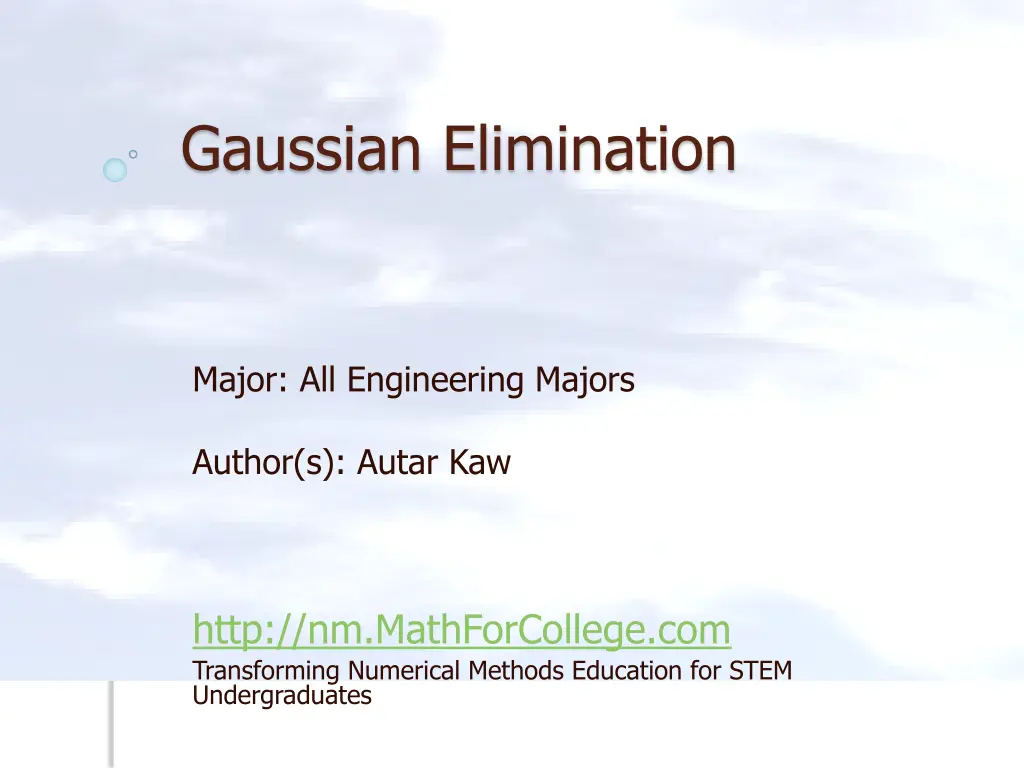
Gaussian Elimination Method in Engineering
Discover the Gaussian elimination method used in engineering to solve simultaneous linear equations, with steps including forward elimination and back substitution. Learn how to find the determinant of a square matrix using naive Gauss elimination. Explore theorems related to determinants and upper triangular matrices.Graphical representations included.
Download Presentation

Please find below an Image/Link to download the presentation.
The content on the website is provided AS IS for your information and personal use only. It may not be sold, licensed, or shared on other websites without obtaining consent from the author. If you encounter any issues during the download, it is possible that the publisher has removed the file from their server.
You are allowed to download the files provided on this website for personal or commercial use, subject to the condition that they are used lawfully. All files are the property of their respective owners.
The content on the website is provided AS IS for your information and personal use only. It may not be sold, licensed, or shared on other websites without obtaining consent from the author.
E N D
Presentation Transcript
Gaussian Elimination Major: All Engineering Majors Author(s): Autar Kaw http://nm.MathForCollege.com Transforming Numerical Methods Education for STEM Undergraduates
Nave Gaussian Elimination A method to solve simultaneous linear equations of the form [A][X]=[C] Two steps 1. Forward Elimination 2. Back Substitution
Forward Elimination The goal of forward elimination is to transform the coefficient matrix into an upper triangular matrix ?1 ?2 ?3 106.8 177.2 279.2 25 64 144 5 8 12 1 1 1 = ?1 ?2 ?3 106.8 96.21 0.735 25 0 0 5 1 = 4.8 0 1.56 0.7
Back Substitution Solve each equation starting from the last equation ?1 ?2 ?3 106.8 96.21 0.735 25 0 0 5 1 = 4.8 0 1.56 0.7
Determinant of a Square Matrix Using Na ve Gauss Elimination Example
Theorem of Determinants If a multiple of one row of [A]nxn is added or subtracted to another row of [A]nxn to result in [B]nxn then det(A)=det(B)
Theorem of Determinants The determinant of an upper triangular, lower triangular or diagonal matrix [A]nxn is given by det A = ?11 ?22 ... ??? ... ??? ? = ??? ?=1
Forward Elimination of a Square Matrix Using forward elimination to transform [A]nxn to an upper triangular matrix, [U]nxn. ?? ? ?? ? det ? = det ?
Example Using Naive Gaussian Elimination method, find the determinant of the following square matrix. 25 64 144 5 8 1 1 1 12
Finding the Determinant After forward elimination steps 25 64 144 5 8 12 1 1 1 25 0 0 5 1 4.8 0 1.56 0.7 . det A = ?11 ?22 ?33 = 25 4.8 0.7 = 84.00
Pitfall#1. Division by zero 10?2 7?3= 3 6?1+ 2?2+ 3?3= 11 5?1 ?2+ 5?3= 9 ?1 ?2 ?3 0 6 5 10 2 1 7 3 5 3 11 9 =
Is division by zero an issue here? 12?1+ 10?2 7?3= 15 6?1+ 5?2+ 3?3= 14 5?1 ?2+ 5?3= 9 ?1 ?2 ?3 12 6 5 10 5 1 7 3 5 15 14 9 =
Is division by zero an issue here? YES ?1 ?2 ?3 12?1+ 10?2 7?3= 15 6?1+ 5?2+ 3?3= 14 24?1 ?2+ 5?3= 28 12 6 24 10 5 1 7 3 5 15 14 28 = ?1 ?2 ?3 12 0 0 10 0 21 7 6.5 19 15 6.5 2 = Division by zero is a possibility at any step of forward elimination
Pitfall#2. Large Round-off Errors ?1 ?2 ?3 20 3 5 15 10 7 3 45 = 2.249 1 1.751 9 Exact Solution ?1 ?2 ?3 1 1 1 =
Pitfall#2. Large Round-off Errors ?1 ?2 ?3 20 3 5 15 10 7 3 45 = 2.249 1 1.751 9 Solve it on a computer using 6 significant digits with chopping ?1 ?2 ?3 0.9625 1.05 0.999995 =
Pitfall#2. Large Round-off Errors ?1 ?2 ?3 20 3 5 15 10 7 3 45 = 2.249 1 1.751 9 Solve it on a computer using 5 significant digits with chopping ?1 ?2 ?3 0.99995 0.625 1.5 = Is there a way to reduce the round off error?
Avoiding Pitfalls Increase the number of significant digits Decreases round-off error Does not avoid division by zero
Avoiding Pitfalls Use Gaussian Elimination with Partial Pivoting Avoids division by zero Reduces round off error
Gauss Elimination with Partial Pivoting http://nm.MathForCollege.com
What is Different About Partial Pivoting? At the beginning of the k th step of forward elimination, find the maximum of ???, ??+1,?,................, ??? If the maximum of these values is ??? in the ?th row, ? ? ?, then switch rows ? and ?.
Example (2nd step of FE) ?1 ?2 ?3 ?4 ?5 6 0 0 0 0 14 7 4 9 17 5.1 6 12 23 12 3.7 1 1 6 11 6 2 5 6 8 9 3 = 11 8 43 Which two rows would you switch?
Example (2nd step of FE) ?1 ?2 ?3 ?4 ?5 ?1 ?2 ?3 ?4 ?5 6 0 0 0 0 14 7 4 9 17 5.1 6 12 23 12 3.7 1 1 6 11 6 2 5 6 0 0 0 0 19 17 4 9 7 5.1 12 12 23 6 3.7 11 1 6 1 6 5 3 8 9 6 8 9 3 43 11 8 2 = = 11 8 43 6
Gaussian Elimination with Partial Pivoting A method to solve simultaneous linear equations of the form [A][X]=[C] Two steps 1. Forward Elimination 2. Back Substitution
Gauss Elimination with Partial Pivoting Example
Solve the following set of equations by Gaussian elimination with partial pivoting ?1 ?2 ?3 106.8 177.2 279.2 25 64 144 5 8 1 1 1 = 12 25 64 144 5 8 1 1 1 106.8 177.2 279.2 12
Number of Steps of Forward Elimination Number of steps of forward elimination is (n 1)=(3 1)=2
Forward Elimination: Step 1 Examine absolute values of first column, first row and below. 25 , 64 , 144 Largest absolute value is 144 and exists in row 3. Switch row 1 and row 3. 144 64 25 12 8 5 1 1 1 279.2 177.2 106.8 25 64 144 5 8 1 1 1 106.8 177.2 279.2 12
Forward Elimination: Step 1 (cont.) Divide Equation 1 by 144 and 144 64 25 12 8 5 1 1 1 279.2 177.2 106.8 64 144= 0.4444 multiply it by 64, . 279.2 0.4444 = 63.99 144 12 1 5.333 0.4444 124.1 . 64 8 1 177.2 124.1 53.10 Subtract the result from Equation 2 63.99 0 5.333 2.667 0.4444 0.5556 Substitute new equation for Equation 2 144 0 25 12 1 279.2 53.10 106.8 2.667 5 0.5556 1
Forward Elimination: Step 1 (cont.) Divide Equation 1 by 144 and 144 0 25 12 1 279.2 53.10 106.8 2.667 5 0.5556 1 25 144= 0.1736 multiply it by 25, . 279.2 0.1736 = 25.00 144 12 1 2.083 0.1736 48.47 . 25 2.083 2.917 5 1 106.8 48.47 58.33 Subtract the result from Equation 3 25 0 0.1736 0.8264 144 0 0 12 1 279.2 53.10 58.33 Substitute new equation for Equation 3 2.667 2.917 0.5556 0.8264
Forward Elimination: Step 2 Examine absolute values of second column, second row and below. 2.667 , 2.917 Largest absolute value is 2.917 and exists in row 3. Switch row 2 and row 3. 144 0 0 12 1 279.2 53.10 58.33 144 0 0 12 1 279.2 58.33 53.10 2.667 2.917 0.5556 0.8264 2.917 2.667 0.8264 0.5556
Forward Elimination: Step 2 (cont.) Divide Equation 2 by 2.917 and multiply it by 2.667, 2.667 2.917= 0.9143. 144 0 0 12 1 279.2 58.33 53.10 2.917 2.667 0.8264 0.5556 58.33 0.9143 = 0 0 2.917 0.8264 2.667 0.7556 53.33 0 2.667 2.667 0.5556 0.7556 0.2 53.10 53.33 0.23 . 0 0 Subtract the result from Equation 3 0 144 0 0 12 1 279.2 58.33 0.23 Substitute new equation for Equation 3 2.917 0 0.8264 0.2
Back Substitution ?1 ?2 ?3 144 0 0 12 1 279.2 58.33 0.23 144 0 0 12 1 279.2 58.33 0.23 = 2.917 0 0.8264 0.2 2.917 0 0.8264 0.2 Solving for a3 0.2?3= 0.23 ?3= 0.23 0.2 = 1.15
Back Substitution (cont.) ?1 ?2 ?3 144 0 0 12 1 279.2 58.33 0.23 = 2.917 0 0.8264 0.2 Solving for a2 2.917?2+ 0.8264?3= 58.33 ?2=58.33 0.8264?3 2.917 =58.33 0.8264 1.15 2.917 = 19.67
Back Substitution (cont.) ?1 ?2 ?3 144 0 0 12 1 279.2 58.33 0.23 = 2.917 0 0.8264 0.2 Solving for a1 144?1+ 12?2+ ?3= 279.2 ?1=279.2 12?2 ?3 =279.2 12 19.67 1.15 144 144 = 0.2917
Gaussian Elimination with Partial Pivoting Solution ?1 ?2 ?3 106.8 177.2 279.2 25 64 144 5 8 1 1 1 = 12 ?1 ?2 ?3 0.2917 19.67 1.15 =
Like what you see. Tell your friends. Subscribe to the NumericalMethodsGuy Channel our goal is to reach 100,000 subscribers.







